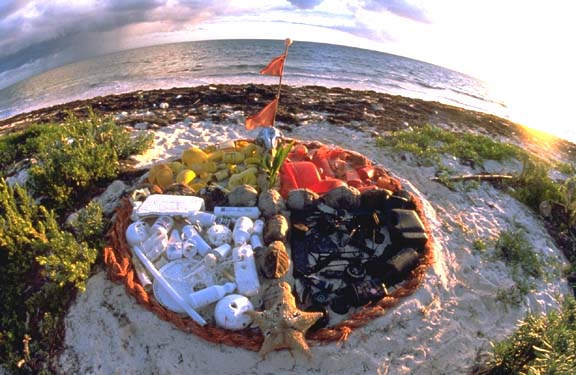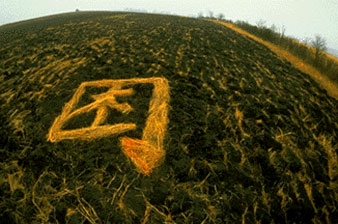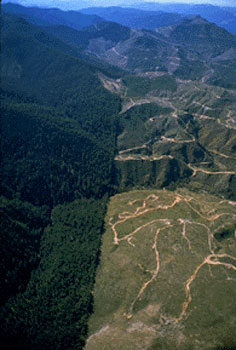|
The Environmental Art & Photography
of
Daniel Dancer

Wheel For Toxic Man
Yucatan, Mexico, 1988.
In an earlier time, art was more than what someone else did for us to collect for the walls and tables of our homes. We were all artists and doing art was a part of life which connected us to the whole of nature. Daniel Dancer's art, events and residencies are an effort to reclaim this way. Whether crafted alone in a sacred manner upon the ravaged areas of Earth, or with a community of others, his way of art is medicine for ourselves and the Wild. His artful practice is a deep way to give thanks for the beauty which surrounds us and to seek forgiveness from Earth for the damage inflicted by humankind. Through story, intention and participation with others, each piece becomes a way to activate a healing responsiveness from our culture. Uncollectable, his works have real and intrinsic value...like Earth herself.

Hexagram 47
"One
of the last virgin Kansas prairies was plowed in 1990. Creating
the I-Ching's symbol for adversity from bordering
native grasses was a way to honor a wildness present since
the last ice age."
Buddhists build mandalas
to stimulate inner wholeness. Navajos construct sand paintings to encourage physical healing. In a similar sense, Daniel Dancer and those that participate with him, create
on site, eco-mandalas to help jump-start the healing and
restoration of damaged lands. By allowing each art offering to shape itself through the natural unfolding of events and found materials, Dancer works in collaboration with Earth. Often
political, his works are expressions of longing and outrage,
ways to Declare Sacred Ground and channel "eco-despair" into action. Once
created, these prayers put into form are offered to the wild and slowly reclaimed by nature. Lessons in impermanence and non-attachment, they cannot be locked up in museums or galleries.
Education & Participation
Dancer's transformational symbols are metaphors for the human
plight and our impact upon Earth. When shared with others in
story and photograph, they become eloquent teaching tools that
help rekindle our connection to wild nature. Created on a community
level, this way of art can galvanize interest on critical,
local peace and environmental issues: water pollution, prairie
restoration, toxic waste, endangered wetlands, deforestation,
etc.. He has facilitated participatory projects of this
nature around the world.

Beluga Peacemaker I
"On an Interspecies Communication trip to the Arctic Circle in 1989 to be with
beluga whales, we saw none in a
Delta traditionally their sanctuary. I built this driftwood beluga in mourning
for their absence ."
The complete story of this adventure is now a book by Author
Jim Nolman called: The Beluga Cafe.
Eco Photography

The Cutting Edge, Standing and clearcut forest in the
Washington Cascades.
The
over-abundance of nature images which flood our society inadvertently
pacify us while real nature slips further and further away. Sensitive to this reality, Dancer became strictly an environmental photographer. "The intent of my work is to balance the beauty of nature with the reality of what continually threatens its destruction, and as well, with the art and restorative ways we employ to protect it." Dancer
champions a deep photography ethic-- a reciprocal relationship where the subject one photographs is honored by some manner of advocacy on its behalf. In 2012 he became the primary photo researcher for the Foundation For Deep Ecology.
"His images dance dark and light through our souls."
Dave Foreman, Executive Director of the Wildlands Project
"Dancer's photographs cut heart strings like a surgeon's knife."
Galen Rowell, renowned photographer and author
"Daniel's fine work shows the truth in Berthold Brecht's statement,
'Art is not a mirror held up to reality, but a hammer by which to shape it."
Dancer wields his hammer with beauty and wisdom."
Derrick Jensen, Author of A Language Older Than Words
The Image that Began it All for
Art For the Sky

In 1989 at the Ojai Foundation in California, I co-led the creation of my first aerial art work: a 100 ft. model of a tail-feather from Topa Topa, the last wild California Condor to be captured. It was both a prayer for the return of the condors and an apology for bringing them to the edge of extinction. The feather became a well-cared for ceremonial site and here's an image in 2015 taken by a drone. Condors fly freely now in the mountains above!
P A S T P R O J E C T S
Participatory Art:
A Collection of Facilitated Projects
Offerings to the Wild:
Art as Medicine for Earth and Ourselves
(presentation)
Z e r 0 C i r c l e s:
An Artful, Nationwide Effort to Protect Public Lands
Rowena Wilds:
A Community in Concert With Nature
|